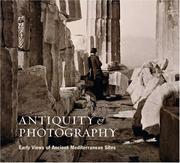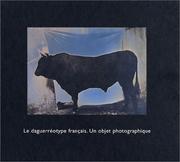| Listing 1 - 6 of 6 |
Sort by
|
Book
Year: 1971 Publisher: Albuquerque University of New Mexico Press
Abstract | Keywords | Export | Availability | Bookmark
 Loading...
Loading...Choose an application
- Reference Manager
- EndNote
- RefWorks (Direct export to RefWorks)


ISBN: 9780892368051 0892368055 Year: 2005
Abstract | Keywords | Export | Availability | Bookmark
 Loading...
Loading...Choose an application
- Reference Manager
- EndNote
- RefWorks (Direct export to RefWorks)
Photography --- Antiquity --- Mediterranean countries --- Photography in archaeology --- Ruins in art --- Calotype --- Daguerreotype --- Photographie en archéologie --- Ruines dans l'art --- Photographie --- Daguerréotype --- Exhibitions. --- History --- Expositions --- Histoire --- Photographie en archéologie --- Daguerréotype --- Exhibitions --- 19th century --- Talbotype --- Photogenic drawing --- Archaeology --- Photography in archaeology - Exhibitions --- Ruins in art - Exhibitions --- Photography - History - 19th century - Exhibitions --- Calotype - Exhibitions --- Daguerreotype - Exhibitions --- Acqui 2006

ISBN: 2711845753 9782711845750 Year: 2003 Publisher: Musée d'Orsay,
Abstract | Keywords | Export | Availability | Bookmark
 Loading...
Loading...Choose an application
- Reference Manager
- EndNote
- RefWorks (Direct export to RefWorks)
Le 7 janvier 1839, le physicien François Arago, lors d'une séance de l'Académie des sciences de Paris, présente un nouveau procédé permettant de reproduire de manière mécanique et chimique, sans intervention manuelle, les images qui se forment dans la chambre obscure: le daguerréotype, marquant ainsi la naissance officielle de la photographie. Image uniqe, sur plaque de cuivre recouverte d'argent, aux reflets changeants, polie, et souvent réfléchissante comme un miroir, l'invention de Daguerre devait définitivement modifier le regard posé sur le monde et ses représentations, artistiques comme scientifiques. C'est bien cet "art nouveau au milieu d'une vieille civilisation", selon le propres termes du savant Gay-Lussac en 1839, que l'exposition et cet ouvrage entendent faire découvrir en s'attachant à la production française, dans toute sa diversité.
Photography --- anno 1800-1899 --- France --- daguerrotypes --- fotografie --- Frankrijk --- Ouvrage collectif sous la responsabilité scientifique de Quentin Bajac et Dominique Planchon-de-Font-Réaulx --- negentiende eeuw --- daguerreotypie --- fotografiegeschiedenis --- Niépce Nicéphore --- Daguerre Louis Jacques Mandé --- portretfotografie --- portret --- amateurfotografie --- Choiselat Marie Charles Isidore --- Ratel Stanislas --- Lerebours Noël-Marie Paymal --- Claudet Antoine --- documentaire --- documentaire fotografie --- monumenten --- kerken --- kastelen --- Girault de Prangey Joseph-Philibert --- Foucault Jean Bernard Léon --- Hossard Paul Michel --- von Martens Friedrich --- stadsfotografie --- Parijs --- landschap --- landschapsfotografie --- Durand Philippe Fortuné --- Salathe Frédéric --- Clausel Alexandre --- Winter Charles-David --- Gaudin Marc-Antoine --- Thibault --- kunst en fotografie --- dieren --- planten --- Millet Désiré François --- fotografie en schilderkunst --- Le Gray Gustave --- Bernabé Camille --- Gouin Alexis --- naakt --- naaktfotografie --- Moulin Jacques-Antoine --- Belloc Auguste --- Braquehais Bruno --- Bayard Hippolyte --- Humbert de Molard Adolphe --- Le Boeuf Eugène --- Descloizeaux Alfred --- Gros Jean-Baptiste Louis --- Itier Alphonse Eugène Jules --- Dubosq Louis-Jules --- fotografie en geneeskunde --- microfotografie --- Bisson Louis-Auguste --- Guillain Charles --- Jacquart Henri --- etnografie --- etnologie --- Thiesson E. --- 77.035 --- CDL --- Exhibitions --- Thiesson E --- Daguerreotype --- History --- daguerreotype [process] --- Frankrijk.
Book
ISBN: 2871830053 Year: 1989 Publisher: Charleroi : Musée de la Photographie,
Abstract | Keywords | Export | Availability | Bookmark
 Loading...
Loading...Choose an application
- Reference Manager
- EndNote
- RefWorks (Direct export to RefWorks)
Catalogues d'expositions --- Fotografie --- Photographie --- Tentoonstellingscatalogi --- fotografie --- 1839 - 1989 --- 19de eeuw --- 20ste eeuw --- Exposition --- Mont-sur-Marchienne --- Stroobant Dominique --- twintigste eeuw --- België --- daguerreotype --- Arago --- luchtfotografie --- holografie --- Jung Dieter --- Bailly-Maître-Grand Patrick --- Bertels André --- Bodson Jean-Marc --- Boonstra Rommert --- Cordier Pierre --- De Jaeger Stefan --- Dieuzaide Jean --- Friedlander Lee --- Gioli Paolo --- Hoblargan P.M. --- Josephson Kenneth --- Lemaître Pascal --- Sack Stephen --- Salaün Philippe --- Sarlet Jean-Michel --- Troispoux Yvette --- Vink John --- 77(091) --- History --- history [discipline] --- photography [process] --- Photography --- geschiedenis --- Hoblargan P.M --- CDL --- 77.03 --- Exhibitions --- 19th century --- 20th century --- History&delete& --- 750 --- photographie XIXe siècle --- photographie --- 1839 - 1989. --- 19de eeuw. --- 20ste eeuw. --- Histoire
Book
ISBN: 1280491833 9786613587060 0226812227 9780226812229 9781280491832 9780226812205 0226812200 Year: 2012 Publisher: Chicago : University of Chicago Press,
Abstract | Keywords | Export | Availability | Bookmark
 Loading...
Loading...Choose an application
- Reference Manager
- EndNote
- RefWorks (Direct export to RefWorks)
In the years immediately following Napoleon's defeat, French thinkers in all fields set their minds to the problem of how to recover from the long upheavals that had been set into motion by the French Revolution. Many challenged the Enlightenment's emphasis on mechanics and questioned the rising power of machines, seeking a return to the organic unity of an earlier age and triggering the artistic and philosophical movement of romanticism. Previous scholars have viewed romanticism and industrialization in opposition, but in this groundbreaking volume John Tresch reveals how thoroughly entwined science and the arts were in early nineteenth-century France and how they worked together to unite a fractured society. Focusing on a set of celebrated technologies, including steam engines, electromagnetic and geophysical instruments, early photography, and mass-scale printing, Tresch looks at how new conceptions of energy, instrumentality, and association fueled such diverse developments as fantastic literature, popular astronomy, grand opera, positivism, utopian socialism, and the Revolution of 1848. He shows that those who attempted to fuse organicism and mechanism in various ways, including Alexander von Humboldt and Auguste Comte, charted a road not taken that resonates today. Essential reading for historians of science, intellectual and cultural historians of Europe, and literary and art historians, The Romantic Machine is poised to profoundly alter our understanding of the scientific and cultural landscape of the early nineteenth century.
Technology --- Utopias --- Machinery --- Science --- Romanticism --- Applied science --- Arts, Useful --- Science, Applied --- Useful arts --- Industrial arts --- Material culture --- Natural science --- Natural sciences --- Science of science --- Sciences --- Machines --- Manufactures --- Power (Mechanics) --- Mechanical engineering --- Motors --- Power transmission --- Ideal states --- States, Ideal --- Utopian literature --- Political science --- Socialism --- Voyages, Imaginary --- Dystopias --- Social aspects --- History --- Philosophy --- Curious devices --- France --- E-books --- napoleon, french revolution, enlightenment, mechanics, machine, romanticism, france, philosophy, industrialization, science, printing, photography, scientific instruments, geophysics, steam engines, electromagnetics, association, energy, instrumentality, utopian socialism, positivism, grand opera, astronomy, fantastic literature, fantasy, mechanism, organicism, auguste comte, alexander von humboldt, daguerreotype, nonfiction.
Book
ISBN: 9780300191806 9781588394866 Year: 2013 Publisher: London : Yale University Press,
Abstract | Keywords | Export | Availability | Bookmark
 Loading...
Loading...Choose an application
- Reference Manager
- EndNote
- RefWorks (Direct export to RefWorks)
Photographes de guerre --- Daguerréotype --- États-Unis --- Photographies --- fotografie --- negentiende eeuw --- Verenigde Staten --- documentaire fotografie --- portretfotografie --- landschapsfotografie --- oorlogsfotografie --- Brady Mathew B. --- Gardner Alexander --- Pelot Alma A. --- O'Sullivan Timothy H. --- Russell Andrew Joseph --- Barnard George N. --- Wood John --- Gibson James F. --- Knox David --- Reekie John --- Wertz George W. --- Armstead George W. --- Fredricks Charles DeForest --- Masury Samuel --- Lewis Richard A. --- Paxson Charles --- Roche Thomas C. --- Gayford & Speidel --- Riddle A.J. --- Bontecou Reed Brockway --- 77.044 --- 77.035 --- Exhibitions --- United States --- History --- Civil War, 1861-1865 --- Pictorial works --- War photography --- Photographies. --- Photography --- History of North America --- photography [process] --- civil wars --- anno 1800-1899 --- Brady Mathew B --- Pelot Alma A --- O'Sullivan Timothy H --- Barnard George N --- Gibson James F --- Wertz George W --- Armstead George W --- Lewis Richard A --- Roche Thomas C --- Riddle A.J
| Listing 1 - 6 of 6 |
Sort by
|

 Search
Search Feedback
Feedback About
About Help
Help News
News